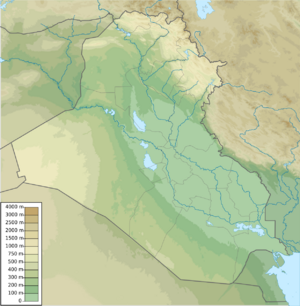Religion:1991 uprising in Basra
| 1991 uprising in Basra | |||||||||
|---|---|---|---|---|---|---|---|---|---|
| Part of 1991 uprisings in Iraq | |||||||||
| |||||||||
| Belligerents | |||||||||
|
| ||||||||
| Commanders and leaders | |||||||||
| Ali Hassan al-Majid[1] | Unknown | ||||||||
| Strength | |||||||||
| 6,000 Republic Guard[2] | 5,000 Army defectors[2] | ||||||||
| Casualties and losses | |||||||||
|
730+ killed 1,300+ wounded | 220+ killed | ||||||||
The 1991 uprising in Basra was the scene of the beginning of the unrest in Iraq following the Gulf War. The uprising started after demoralized troops throughout Iraq began to rebel against Saddam Hussein's Ba'athist regime, in particular after a tank driver in Basra fired at a public portrait of Saddam Hussein. Basra became a chaotic battlefield between military defectors and Iraqi Republican Guard, with most of the fighting taking place at close quarters. Most of Basra had been retaken by mid March, but rebels in parts such as Tanuma managed to hold out until mid April. After Ba'athist forces had regained control, they engaged in a crackdown against civilians and suspected supporters of the uprising.[3]
Uprising
1 March
The turmoil began in Basra on 1 March 1991, one day after the Gulf War ceasefire, when a T-72 tank gunner returning home after Iraq's defeat in Kuwait fired a shell into an enormous portrait of Saddam Hussein hanging over the city's main square and the other soldiers applauded.[4][5]
4 March
By 4 March, the forces loyal to Saddam Hussein had managed to gain the upper hand in the battle, and began a brutal counter-offensive characterised by the arbitrary killing of civilians, with government tanks reportedly firing at buildings and civilians and Republican Guardsmen engaging in massacres against the civilian population. The fighting entered a stand-still by early April and the local resistance and the Republican Guardsmen entered a truce.[6]
References
- ↑ "Fear at the end of the Basra road". The Guardian. 18 May 1991. https://www.theguardian.com/world/1991/may/18/iraq.edvulliamy. Retrieved 21 October 2012.
- ↑ 2.0 2.1 Goldstein, Eric (June 1992). Endless Torment: The 1991 Uprising in Iraq and Its Aftermath. 350 Fifth Avenue 34th Floor, New York, N.Y.: Human Rights Watch. p. 45. ISBN 1-56432-069-3. https://books.google.com/books?id=zWVRzLncwIoC&printsec=frontcover&source=gbs_ge_summary_r&cad=0#v=onepage&q&f=false.
- ↑ Goldstein, Eric (June 1992). Endless Torment: The 1991 Uprising in Iraq and Its Aftermath. 350 Fifth Avenue 34th Floor, New York, N.Y.: Human Rights Watch. p. 48. ISBN 1-56432-069-3. https://books.google.com/books?id=zWVRzLncwIoC&printsec=frontcover&source=gbs_ge_summary_r&cad=0#v=onepage&q&f=false.
- ↑ The Crimes of Saddam Hussein: Suppression of the 1991 Uprising, PBS Frontline, 24 January 2006.
- ↑ Flashback: the 1991 Iraqi revolt, BBC News, 21 August 2007.
- ↑ Goldstein, Eric (June 1992). Endless Torment: The 1991 Uprising in Iraq and Its Aftermath. 350 Fifth Avenue 34th Floor, New York, N.Y.: Human Rights Watch. p. 46. ISBN 1-56432-069-3. https://books.google.com/books?id=zWVRzLncwIoC&printsec=frontcover&source=gbs_ge_summary_r&cad=0#v=onepage&q&f=false.
External links



